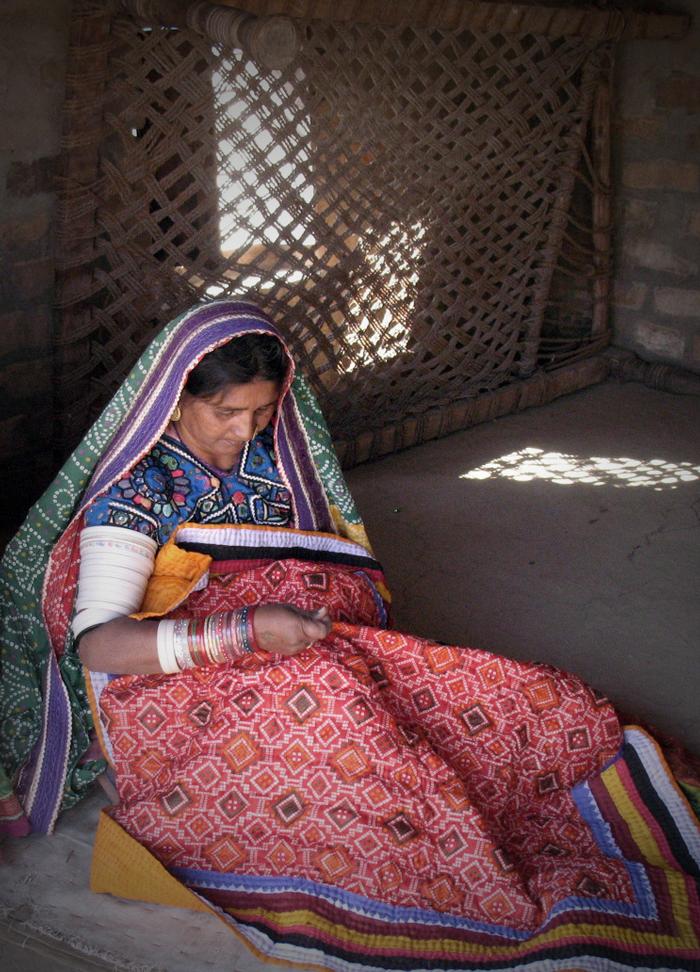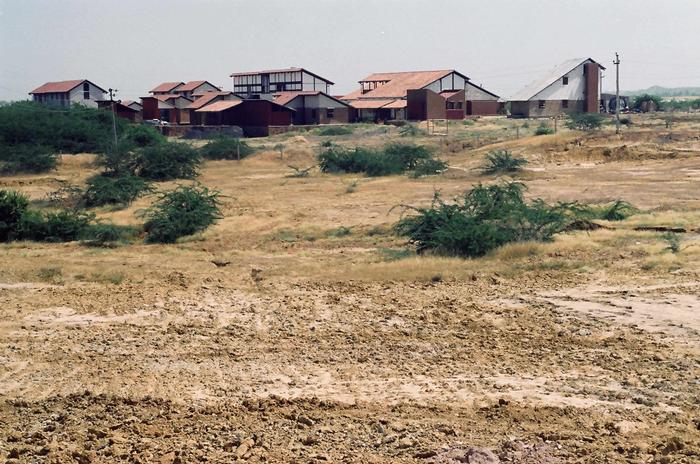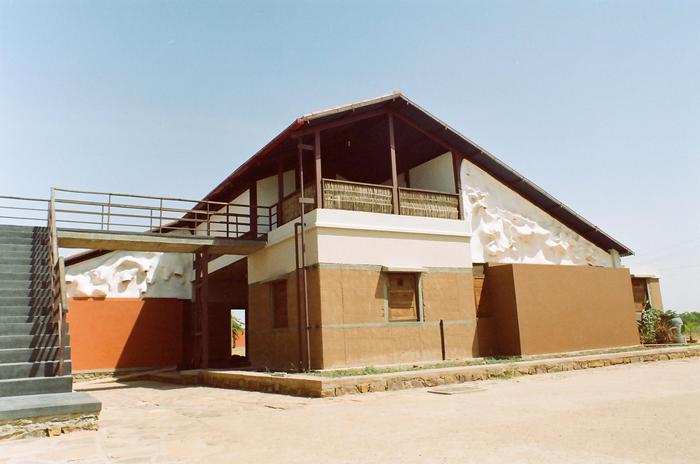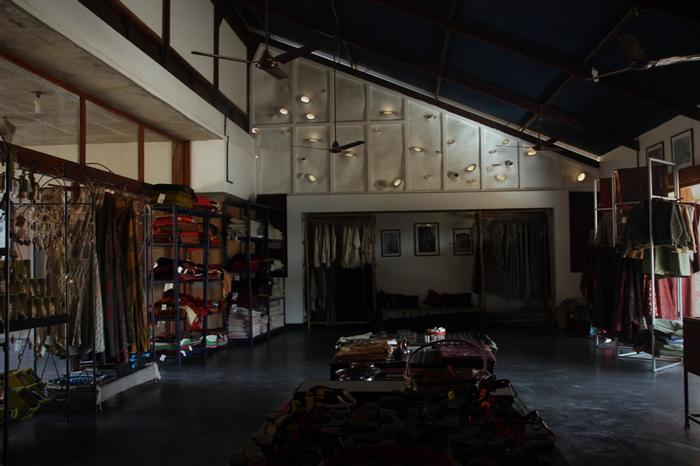[ID:255] “So Heddan, So Hoddan” (As here, so there)India Kutch is marked by the pain of partition of land, loss and grief of human life and relationships. A medieval Sufi poet, Shah Abdul Latif Bhitai, composed poems that are sung by communities in Kutch even today. They could be called travelling songs of the region as they belong to a tradition of story telling and an essential nomadic culture. As the philosophy exemplifies a 'profound Sufi exploration of the distance between our inner self and us, and also between two people is the purpose of these compositions.' I began my journey with a cursory knowledge of this backdrop and with a purpose to connect architecture with culture, history, tradition and craft.
After an overnight bus journey from Ahmedabad, wearing an indigo shirt, I disembarked at Kukma, a small village on the highway in Western India. As I stopped to have tea at a roadside shop a group of nomads welcomed me, in what proved to be an instant conversation with the resilient people of Kutch. Their stock of cattle, which included cows, sheep and camels, had raised a huge cloud of dust, complimenting their spontaneous narration of the unforgiving climate and the arduous arid landscape, forcing a travel of few hundred kilometers to find grazing land. These Maldharis (pastoral tribesmen) were dressed in bright colors with shiny mirror work on their clothes and stood with immense pride. Their gleaming skin was adorned with robust silver anklets, arms packed with lacquered bangles and earlobes hanging with the weight of earrings.
The conversation led me through the interiors of the village where I noticed white line drawings on mud walls of the houses that exemplified the community life of the people. The vibrant illustrations on the walls were of festivities, of pastoral tribesmen with their cattle, of the sacred tree, of household things and aesthetic patterns. The rhythmic knocking drew me into the house where a hand-operated loom occupied the entire veranda. The artisan, who was busy weaving a shawl of dyed sheep wool, gave me a ritual offering of water from the clay pot. Handcrafted objects from embroidered wall hangings to clay utensils, from lacquered wood furniture to kitchen knives, comprised of a proud display of their talent and creativity.
Craft in Kutch is an integral part of lifecycle rituals and is a means of self-reliance in a region that faces severe climatic conditions and frequent natural calamities. Each community has a distinct identity. Over time, the Meghwals have established themselves as weavers and embroiderers of cloth and leather, the Luhars as the community making copper plated bells, the Khatris as block-printers and fabric dyers, the Wadha community pioneering the art of lacquer coated lathed wood for household items and furniture along with the Sonis who produce exquisite silverware and silver jewelry.
Till recently, these crafts faced a threat of becoming poignant reminders of dying traditions in the face of competition from more modern, mass products. Small and medium scale artisans did not have access to raw materials that were channelized towards large industries. Further, the rising raw material costs, difficulties in obtaining credit and insurance from banks and the lack of exposure to modern innovation made it impossible to continue with production and market handmade products on a competitive platform.
In the year 2001, a massive earthquake shook Kutch. The artisans lost their workshops, equipment and most of all, their morale to pursue handicrafts as their primary livelihood. Simultaneously the government, in an attempt to recover from the destruction, promoted industrialization in the region that led to a migration of skilled craftsperson to factories as daily wage labor. This drastic measure, in a matter of a decade, would have eradicated layers of traditional knowledge belonging to the craft communities. The uncontrolled reconstruction process that followed was driven strongly by economic forces, which disconnected the acts of building and dwelling. The sense of dwelling was lost with the loss of a familiar environment, people could neither identify with the appearance of their surroundings nor could they inhabit the alienating space.
Architecture as Gathering: Life in the Landscape
“The bridge gathers the earth as landscape around the stream… It does not just connect banks that are already there. The banks emerge as banks only as the bridge crosses the stream.” -Martin Heidegger
It was at this juncture when architect Neelkanth Chhaya, who built the Khamir Crafts Resource Center, faced challenges from both frontiers, that of building an architecture in the fragile ecology of the region while respecting its traditional spatial typologies that form a sense of dwelling. The design is a precarious balance of local skills along with expertise of the engineer. The building activity was envisioned as an assimilation of regional, social and material, processes that would ground the architecture in the particularities of the landscape. Materials were appropriated as processual entities, as part of a larger ecological cycle, which make the building permeable to its surroundings.
It was in the vast sparsely vegetated landscape of Kutch and amongst the people that the Khamir Crafts Resource Centre found its raison d’etre. Khamir was set up as a joint initiative of the Kutch Nav Nirman Abhiyan and Nehru Foundation for Development to cultivate the craft traditions of the region. The objective was to revitalize, reposition and promote the traditional crafts of Kutch such that they remain a viable and sustainable source of income for artisan communities. Khamir in Kutchi stands for ‘intrinsic pride’ of the artisans in their crafts. The architecture has uplifted the artisan by recognizing his frugal way of life, respecting and building upon the complex web of economic, social and cultural relationships. Though the centralized notion of a crafts centre is against the crafts as a decentralized resource of every home in Kutch, Khamir balances the tensions between this polarity.
The architecture, while housing such a complex program, has been humbled by it. It subtly takes the form of a crafted object, which gathers people, material, crafts, technology, the village and the city. It stands in the midst of the arid landscape as a house for crafts as live traditions of knowledge. The architect’s holistic approach towards building as a means to dwell has reinforced their beliefs and has built an identity that they represent to each other and to the world at large. The architecture is also meant to address the deep-seated anxieties through its design as an earthquake resistant structure, which employed ingenious cost-effective techniques.
The architect in discussion with structural engineer Himanshu Parikh worked out a modular plan. The footprint of the buildings was strategically optimized and kept regular such that seismic loads could be accounted for. Similarly the building materials were made heavy at the base and lighter as they moved upwards to reduce the movement of the structure during an earthquake. The monolithic rammed earth walls act as structural cores. Concrete bands tie the walls at plinth and lintel levels, from where the structure continues in steel, wood and wattle & daub infill panels. A lightweight steel roof shades the entire structure.
Character, Identity and a Sense of Dwelling: A Culturally Relevant Architecture
“Architecture may be defined as the making of places” -Christian Norberg-Schulz
The strength of using local materials and indigenous techniques for construction in Khamir lies in the bodily experience that they invoke. The textured surfaces are aides-mémoires of light, sound and smell of Kutchi villages. The mud walls of the crafts centre receive and reflect light in a manner familiar to the artisan. When sprinkled with water, they emanate the known smell of mud and cow dung, a feature of most pastoral villages in the region. The thick walls absorb the ringing sound of the mallets from the workshops, leaving only a subdued rhythmic knocking in the air.
The buildings stand on stout plinths made in random rubble masonry in a land that is mostly flat with gentle undulations, where the stones are hard and difficult to shape. The rammed earth walls rise from the plinth. Ramming earth within a formwork is derived from a local mud construction technique, which makes the walls structurally sound. The layers of mud remain visible on the walls as remnants of the construction process. In parts, the walls are plastered with a mixture of mud and dried cow dung, a traditional technique that keeps the interiors protected and climatically comfortable.
As the structure rises above the ground level it becomes slender and more refined in comparison with the rough robust walls it stands upon. The lightweight steel construction allows for a generous space, its polished black flooring dimming the light inside, quieting the interiors and keeping the floor cool. The white wattle and daub panels inserted between wooden frames insulate the insides from the harsh climate, while the long horizontal windows reveal only glimpses of the landscape. The roof wraps itself around the vertically extended space. This self-contained space disconnects one from the outside yet the travelling sound unites one with the marked presence of the artisans, toiling in their workshops to produce the finest of handicrafts.
The seemingly simple orthogonal plan of Khamir offers one of the most complex sequences of movement. The gaps between the buildings reveal only parts of the buildings and landscape behind, provoking movement along the diagonal. The movement through the verandas of the workshop buildings across a series of shaded courtyards recreates the winding patterns of the village, from courtyard to courtyard, from one house to another. The gradual progression from the harsh sunlit landscape to the shaded courtyard, then the sheltered veranda and finally into the dark and moist interiors is a reminiscence of the traditional spatial sequence in the villages of the region.
As I moved, my feet made contact with the different surfaces along the way, from warm sand to the rough stone paving in the courtyard and then to the coolth of the polished floor, which made for a haptic rather than a visual experience. The architecture consciously provokes an embodied sense of refuge from the severities of nature. It allows for a deeper absorption of our surroundings, protecting us on one hand while tweaking our awareness on the other.
The workshops, similar to the traditional domestic workspaces, comprise of a semi-open veranda enclosed by robust blocks of mass on its three sides, orienting the open side of the veranda to the courtyard. These rooms host the supporting functions such as storage of raw materials and packing materials, a space for a research and development unit and a small display area for the produce. Often the artisans occupy it as an extension of their workspace, a place to keep their tools. A large lightweight steel roof covers the rooms and the veranda making it a singular recognizable unit. The dyeing and weaving workshops are constructed using local wooden logs as columns and a thatch roof with country tiles. The dyed yarn and fabric, colored in bright shades of blue, purple, green, pink and indigo, are left hanging on wires in the shade.
The administration and the exhibition spaces are combined into a single two-storey type. The small office spaces, which are located on the ground level, are constructed with rammed earth and share an intimate scale. The floor above is constructed in steel frames with infill panels, which have been utilized as exhibition spaces on one hand and as a depot for storage of raw materials. The infill walls at this level are very thin, made with wattle and daub technique, which permit the sound through but keep the heat at bay. The view from the raised verandas at this level reconnects one with the landscape. A similar building houses the retail and conference spaces, which are unpretentious linear blocks with a pitch roof. The gable ends of the walls are creatively dealt with, where large panels made from plaster and wire mesh are installed which let a tranquil light into the room.
The character of the retail space on the ground level is the only departure from the rustic feel of the complex. As one enters this space, the overwhelming view of the landscape framed by the horizontal concrete doorframe takes over ones senses. The mirror like polished black flooring reflects the dull shades of brown and dried green on the floor. It takes a moment to recover from the effects of the powerful vista as the pupils begin to adjust to the darkness of the room. The space gently unfolds revealing the racks of intricately made handicrafts. This space gathers the arduous character of the landscape putting in perspective the conditions under which these crafts are produced.
The residential buildings are more humble in comparison with the others. They are carefully positioned in the relatively private and calm diagonal extreme of the campus. A community kitchen serves well for all the guests, the administrative staff and the in-house artisans, who gather around the plinths near the kitchen to dine.
Khamir is a classic testimony to an architectural translation of a sensitive and planned economic model giving hope to a landscape threatened by natural and man-made calamities. In what can be called futuristic, the design cell at Khamir repositions the craft products with innovative designs of modern everyday products made by traditional techniques and brings together designers and craftsmen to make suitable products for the modern market. Khamir also organizes workshops where artisans, material engineers and designers come together to identify the potential and share their expertise to develop the craft in the context of the urban market.
Today, over 60,000 families depend on crafts as their source of livelihood. Khamir has produced a series of documentations of craft technologies and artisans’ works, which has given artisans recognition at national and international competitions. Exhibited at Khamir and collected over the previous century, the textiles reveal how the intricately embroidered pastoral gown or the delicately woven wall hanging were artifacts not made for museums but were living proofs of a community’s belief systems and traditions. Khamir has cultivated this narrative as the philosophy through which these crafts are nurtured, such that the artisan’s pride is sustained.
But it's a struggle that cannot be dreamt away. The older generations of the landscape and the Khamir volunteers are only too aware of the struggle to keep alive not just the crafts, but the syncretic traditions that come with this immense creativity. Kutch, as the Sufi poet Shah Abdul Latif Bhitai dreamt, was a land of rich diversity, survival, suffering and transcendence. The architecture has a dream to keep, of an ancient tradition that kept the land and its people together through the vibrant imaginations of many nomadic storytellers. Truly, as Shah Abdul said, “So Heddan, So Hoddan!”
If you would like to contact this author, please send a request to info@berkeleyprize.org. |




